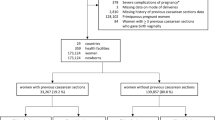Abstract
Objective:
To compare neonatal and maternal outcomes of attempted operative vaginal delivery with emergency repeat cesarean in trial of labor after cesarean.
Study design:
Prospective 8-year cohort analysis using the Netherlands Perinatal Registry, including women with one prior cesarean giving birth through operative vaginal delivery or emergency repeat cesarean (n=12860). A multivariate analysis was performed. Odds ratios (OR) and adjusted odds ratios (aOR) were calculated.
Results:
Attempted operative vaginal delivery increases the risk on neonatal birth trauma (aOR 15.0 (5.94 to 38.0)) and postpartum hemorrhage (aOR 2.59 (2.17 to 3.09)), and lowers the risk of wet lung syndrome (aOR 0.53 (0.35 to 0.80)) and neonatal convulsions (aOR 0.47 (0.24 to 0.91)).
Conclusion:
We found a highly increased risk of neonatal birth trauma and a moderately increased risk of postpartum hemorrhage but slightly lower risks of wet lung syndrome and neonatal convulsions after attempted operative vaginal delivery compared with emergency repeat cesarean.
This is a preview of subscription content, access via your institution
Access options
Subscribe to this journal
Receive 12 print issues and online access
$259.00 per year
only $21.58 per issue
Buy this article
- Purchase on Springer Link
- Instant access to full article PDF
Prices may be subject to local taxes which are calculated during checkout

Similar content being viewed by others
References
Tromp M, Ravelli ACJ, Méray N, Reitsma JB, Bonsel GJ . An efficient validation method of probabilistic record linkage including readmissions and twins. Meth Inform Med 2008; 47: 356–363.
Méray N, Reitsma JB, Ravelli ACJ, Bonsel GJ . Probabilistic record linkage is a valid and transparent tool to combine databases without a patient identification number. J Clin Epidemiol 2007; 60: 883–891.
Stichting Perinatale Registratie Nederland. Perinatale Zorg in Nederland 2007. Stichting Perinatale Registratie Nederland: Utrecht, 2009.
Schaaf JM, Hof MH, Mol BW, Abu-Hanna A, Ravelli AC . Recurrence risk of preterm birth in subsequent singleton pregnancy after preterm twin delivery. Am J Obstet Gynecol 2012; 207: 279.e1–279. e7.
Kessous R, Tirosh D, Weintraub AY, Benshalom-Tirosh N, Sergienko R, Sheiner E . Second stage disorders in patients following a previous cesarean section: vacuum versus repeat cesarean section. Arch Gynecol Obstet 2012; 287: 1075–1079.
Murphy DJ, Liebling RE, Patel R, Verity L, Swingler R . Cohort study of operative delivery in the second stage of labour and standard of obstetric care. Brit J Obstet Gynaec 2003; 110: 610–615.
Contag SA, Clifton RG, Bloom SL, Spong CY, Varner MW, Rouse DJ et al. Neontal outcomes and operative vaginal delivery versus cesarean delivery. Am J Perinatol 2010; 27: 493–499.
Walsh CA, Robson M, McAuliffe FM . Mode of delivery at term and adverse neonatal outcomes. Obstet Gynecol 2013; 121: 122–128.
MacDorman M, Declercq E, Menacker F . Recent trends and patterns in cesarean and vaginal birth after cesarean (VBAC) deliveries in the United States. Clin Perinatol 2011; 38: 179–192.
Selo-Ojeme D, Sathiyathasan S, Fayyaz M . Caesarean delivery at full cervical dilatation versus caesarean delivery in the first stage of labour: comparison of maternal and perinatal morbidity. Arch Gynecol Obstet 2008; 278: 245–249.
Alexander JM, Leveno KJ, Rouse DJ, Landon MB, Gilbert S, Spong CY et al. Comparison of maternal and infant outcome from primary cesarean delivery during the second compared with first stage of labor. Obstet Gynecol 2007; 109: 917–921.
Acknowledgements
We would like to thank all Dutch perinatal health-care professionals for registration of perinatal information. We would like to thank the Foundation of the Netherlands Perinatal Registry (PRN, www.perinatreg.nl) for permission to use the registry data (registration number 12.20).
Author information
Authors and Affiliations
Corresponding author
Ethics declarations
Competing interests
The authors declare no conflict of interest.
Rights and permissions
About this article
Cite this article
Rietveld, A., Kok, N., Kazemier, B. et al. Trial of labor after cesarean: attempted operative vaginal delivery versus emergency repeat cesarean, a prospective national cohort study. J Perinatol 35, 258–262 (2015). https://doi.org/10.1038/jp.2014.216
Received:
Revised:
Accepted:
Published:
Issue Date:
DOI: https://doi.org/10.1038/jp.2014.216
This article is cited by
-
Vacuum extraction delivery at first vaginal birth following cesarean: maternal and neonatal outcome
Archives of Gynecology and Obstetrics (2020)



